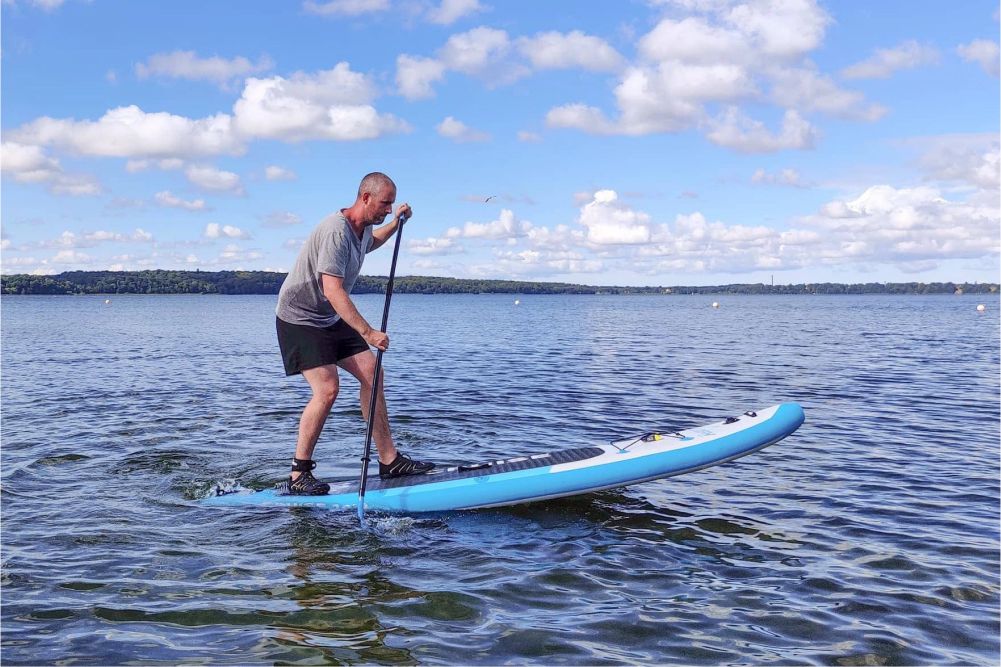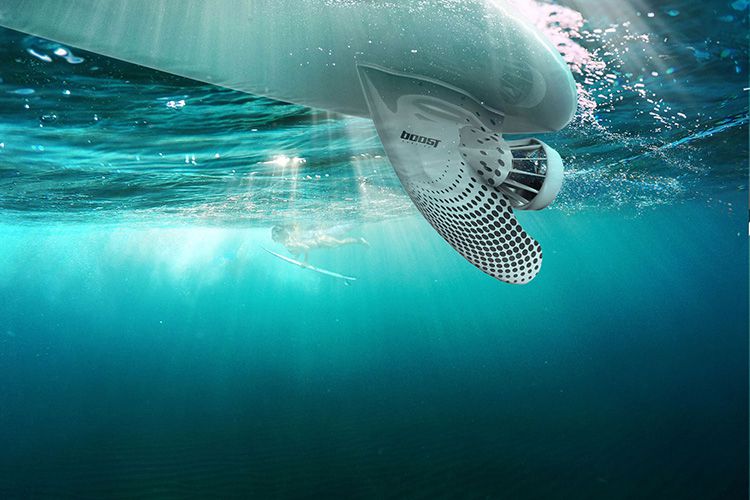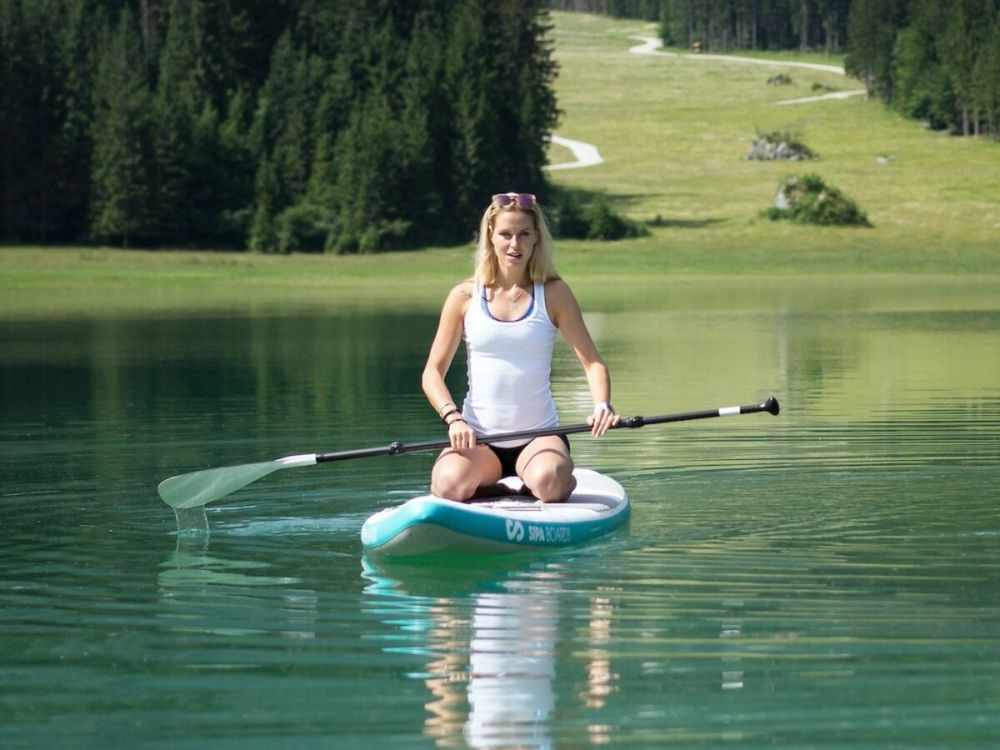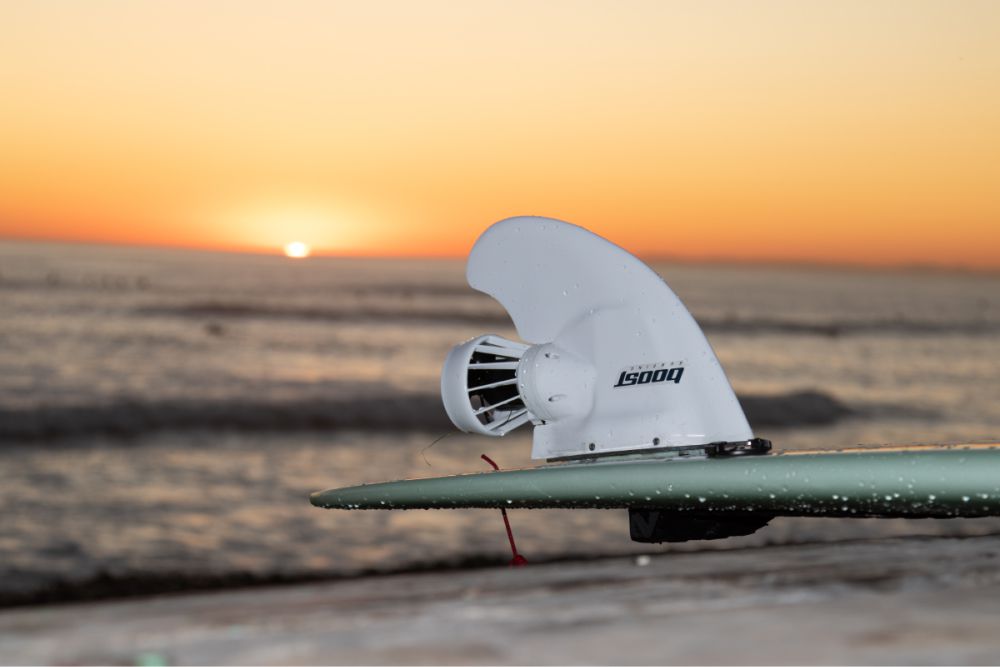Un llamado a los aventureros que dan la bienvenida al futuro de la exploración acuática, donde la innovación tecnológica se combina con la emoción del agua. Saluda al compañero ideal: la tabla de remo eléctrica . Este equipo revolucionario es tu boleto a exploraciones ilimitadas, que da la bienvenida tanto a los expertos en remo como a los curiosos que se adentran por primera vez en el agua. Es hora de revelar los detalles.
¿Qué es una tabla de paddle surf eléctrica?
El La tabla de remo eléctrica , o eSUP como se la llama cariñosamente, es una embarcación única que te da la libertad de remar manualmente o encender el motor de aleta eléctrica para un viaje tranquilo o cargado de adrenalina.
En lo que respecta a las tablas de surf eléctricas, se trata de dos tipos: motores integrados y aletas eléctricas desmontables. Sabemos que esto te ha intrigado, por lo que te espera una sorpresa a medida que profundizamos en este fascinante mundo.
Tabla de surf de remo eléctrica: E-SUP vs. E-Fin
Cuando se sopesan los pros y los contras de los motores integrados frente a las aletas eléctricas desmontables, puede resultar un poco abrumador. No se preocupe, esta comparación tiene como objetivo arrojar luz sobre estas dos opciones:
E-SUP (Tabla de Stand-Up Paddle Surf Eléctrica)

Ventajas:
- Sistema integrado : en un E-SUP, el motor generalmente está integrado en la tabla, lo que proporciona una experiencia perfecta.
- Mejor estabilidad : la tabla está diseñada específicamente para soportar el peso y la potencia adicionales del motor, lo que la hace generalmente más estable.
- Facilidad de uso : Generalmente es más fácil de usar para principiantes, ya que todo el sistema está integrado.
- Diseño optimizado : la forma de la placa y el motor están diseñados para funcionar en armonía, lo que a menudo resulta en un mejor rendimiento general.
- Simplicidad de compra única : no necesita pensar en la compatibilidad entre la placa y el motor, ya que viene como un paquete.
Contras:
- Costo : Generalmente más caro que una tabla de SUP tradicional o un sistema E-Fin.
- Peso : Generalmente más pesado debido al sistema de motor integrado, lo que lo hace un poco engorroso de transportar.
- Menor modularidad : no es fácil actualizar ni cambiar el sistema de motor.
- Opciones limitadas : menos opciones de diseño y estilo en comparación con las tablas de SUP tradicionales.
E-Fin (Sistema de aleta eléctrica)

Ventajas:
- Versatilidad : puedes conectar el sistema E-Fin a prácticamente cualquier tabla de surf de remo, transformándola en una tabla de remo motorizada y ampliando tus opciones.
- Modularidad : Fácil de actualizar o cambiar el motor sin tener que reemplazar toda la placa.
- Rentable : generalmente es más barato que comprar un E-SUP si ya tienes una tabla de SUP compatible.
- Más ligero : el sistema E-Fin desmontable suele ser más ligero que un sistema de motor integrado, lo que hace que la tabla sea más fácil de transportar una vez desmontada.
- Personalización : permite una mayor personalización de su experiencia de remo.
Contras:
- Problemas de compatibilidad : es posible que no todas las tablas de SUP sean compatibles con todos los sistemas E-Fin.
- Requiere ensamblaje : generalmente se necesita cierta configuración para colocar el E-Fin en la tabla, aunque generalmente es sencillo.
- Posibilidad de desajuste : si no se elige con cuidado, el sistema E-Fin podría ser demasiado potente o no lo suficientemente potente para su tabla de SUP, lo que afectaría el rendimiento y la estabilidad.
- Compra adicional : si aún no tienes una tabla de SUP, tendrás que comprar una además del sistema E-Fin, lo que podría resultar menos rentable.
A continuación se muestra una tabla que le ayudará a comparar fácilmente las características, ventajas y desventajas del sistema E-SUP y E-Fin:
| Característica | Tabla de remo eléctrica incorporada | Aleta de tabla de remo eléctrica |
|---|---|---|
| Integración | Diseñado a medida para el tablero | Muy versátil; se puede añadir a cualquier SUP. |
| Características adicionales | Puede incluir GPS, inflado automático, luces LED. | Fácil de colocar y quitar; curva de aprendizaje rápida |
| Eficiencia de la batería | 3-5 horas de uso continuo | Hasta 100 minutos de uso con carga rápida |
| Versatilidad | Limitado a la placa específica | Desmontable; se puede utilizar en varias tablas. |
| Peso | 40-48 libras (tabla + motor) | Agrega solo 2,7 libras al peso de la placa existente |
Por lo tanto, si valoras la versatilidad, el peso más ligero y la simplicidad general, la aleta eléctrica es la mejor opción. Si comprendes estos diferentes aspectos, podrás tomar una decisión informada que se adapte mejor a tus necesidades para una aventura acuática electrizante.
La mejor aleta eléctrica para paddle surf
Si ya estás convencido de las ventajas de una aleta eléctrica en comparación con un motor integrado para tu tabla de SUP (Stand Up Paddle Board), el siguiente paso lógico es encontrar la mejor aleta eléctrica del mercado. Y, según las reseñas de los expertos, hay un nombre que destaca: Boost Fin. Entonces, ¿por qué exactamente Boost Fin se está ganando los elogios que está recibiendo? Vamos a analizarlo.
Diseño liviano
El peso ligero de 2,7 libras de Boost Fin lo distingue de las tablas de remo con motor incorporado, que pueden pesar más de 40 a 50 libras. Esto significa menos resistencia en el agua y un transporte más fácil en tierra, porque seamos realistas, ¿quién quiere cargar con una tabla pesada después de un día agotador de diversión en el agua?
Compatibilidad de materiales
Uno de los aspectos más atractivos de Boost Fin es su compatibilidad versátil con los materiales. Diseñada a partir de una mezcla de polímero reforzado con fibra de vidrio y plástico ABS, se puede adaptar fácilmente a la mayoría de las tablas de remo. Esto abre un mundo de posibilidades para los entusiastas del SUP, ya que les permite adaptar sus tablas existentes con facilidad.
Potencia y velocidad
Fabricado con una batería con una notable capacidad de 3500 mAh a 24 V y 84 Wh, este Boost Fin puede generar hasta 800 W de potencia, lo que permite un empuje máximo de 20 libras y una velocidad máxima de hasta 10 mph. ¡Eso sí que es digno de escribir!
Carga rápida
Si bien los tiempos de carga de las tablas de surf eléctricas integradas suelen oscilar entre 3 y 4 horas, Boost Fin ofrece una experiencia más cómoda. Aunque no se indica el tiempo de carga específico, la batería de iones de litio de alta capacidad suele cargarse más rápido, lo que te da más tiempo para disfrutar del agua.
Alta versatilidad
La aleta Boost Fin no es solo otro dispositivo para agregar a su arsenal de deportes acuáticos; es un accesorio innovador. Con su gran versatilidad, ofrece una solución para los remadores que desean cambiar entre una experiencia manual y una eléctrica sin problemas.
Las 4 mejores tablas de surf de remo eléctricas integradas
Si su pasión por el paddle surf se inclina hacia una experiencia totalmente integrada, donde el motor y la tabla son una unidad perfecta, entonces estos 4 mejores tablas de remo eléctricas son para ti
1. Tabla de surf de remo eléctrica Sipaboards
El Tabla de surf de remo eléctrica Sipaboards es una experiencia acuática completa para los entusiastas del paddle surf. Con una velocidad máxima de 13 km/h y una duración de batería de 3 horas, esta tabla ofrece una combinación perfecta de durabilidad y rendimiento. Características especiales notables como el GPS y el inflado automático la convierten en una todoterreno. Está construida con un marco de 20 kg que garantiza la estabilidad sin comprometer la agilidad.

-
Ventajas:
- Integración de GPS para seguimiento avanzado
- Función de inflado automático para mayor comodidad.
- Duración de batería sólida
-
Contras:
- Versatilidad limitada debido al motor incorporado
- Tiempo de carga de 3 horas
2. JOBE E-Duna
Conoce a los JOBE E-Duna , una obra maestra diseñada para tu comodidad y disfrute. Con una velocidad máxima de 11 km/h y una duración de batería ampliada a 2,5 horas. Sin mencionar las luces LED y una plataforma antideslizante, la tabla brilla tanto por su funcionalidad como por su diseño moderno. Pesa 18 kg, lo que la hace más ligera en comparación con otras. tablas de remo con chorro eléctrico En su clase.
-
Ventajas:
- Luces LED para una mejor visibilidad.
- Cubierta antideslizante para mayor seguridad.
- Peso más ligero
-
Contras:
- Versatilidad limitada debido al motor incorporado
- Menor duración de la batería
3. Pala eléctrica de par motor
El Pala eléctrica de par motor Destaca por su almacenamiento integrado y sus capacidades de GPS. Con una velocidad máxima más alta de 10 mph y una duración de batería de 4 horas, ofrece tanto rendimiento como resistencia. La tabla pesa 42 libras, logrando un equilibrio entre estabilidad y maniobrabilidad.

-
Ventajas:
- Almacenamiento incorporado para mayor comodidad.
- Mayor duración de la batería
- Integración GPS
-
Contras:
- Versatilidad limitada debido al motor incorporado
- Tiempo de carga de 2,5 horas
4. Tabla de remo motorizada Rover
Por último, pero no menos importante, el Tabla de remo motorizada Rover Lleva la potencia y el rendimiento a la vanguardia. Con una velocidad máxima de 12 mph y una impresionante duración de batería de 5 horas, establece un nuevo estándar en el tabla de remo eléctrica mercado. La tabla tiene una gran capacidad de peso y características de autoinflado, lo que la convierte en una excelente opción para riders más pesados o aquellos que llevan equipo adicional.
-
Ventajas:
- Alta velocidad máxima
- Impresionante duración de la batería
- Alta capacidad de peso
-
Contras:
- Versatilidad limitada debido al motor incorporado
- Tiempo de carga de 4 horas
¿Qué tan rápida es la tabla de remo eléctrica?
Una tabla de surf de remo eléctrica puede alcanzar velocidades de entre 5 y 8 kilómetros por hora (entre 3 y 5 millas por hora). Algunos modelos de alto rendimiento pueden alcanzar velocidades más rápidas, potencialmente hasta 16 kilómetros por hora (10 millas por hora) o más.
Para ayudarle a optimizar su proceso de toma de decisiones, hemos creado una tabla de comparación basada en datos entre SUP con motor eléctrico.
| Característica | Tabla de surf de remo eléctrica Sipaboards | JOBE E-Duna | Pala eléctrica de par motor | Tabla de remo motorizada Rover |
|---|---|---|---|---|
| Velocidad máxima (mph) | 8 millas por hora | 7 mph | 10 mph | 12 millas por hora |
| Duración de la batería (horas) | 3 horas | 2,5 horas | 4 horas | 5 horas |
| Tiempo de carga (horas) | 3 horas | 3 horas | 2,5 horas | 4 horas |
| Peso de la placa/motor (lbs) | 45 libras | 40 libras | 42 libras | 48 libras |
| Características especiales | GPS, inflado automático | Luces LED, plataforma antideslizante | Almacenamiento incorporado, GPS | Autoinflable, gran capacidad de peso. |
Con estas características saliendo a la luz, se facilitará el camino para que los entusiastas del paddle surf puedan tomar la decisión correcta.
¿Cuánto cuesta una tabla de remo eléctrica?
La electrificación de la experiencia del paddle surf ya es una realidad gracias a las tablas de surf de remo y las aletas eléctricas. Pero seamos realistas, la electricidad no es barata.

El costo promedio de una tabla de surf eléctrica
Acerca de Tablas de surf de remo eléctricas : el rango de precios fluctúa según la marca, el rendimiento y las funciones adicionales, pero se trata de una cifra aproximada de entre 2000 y 6000 dólares. Si desglosamos el precio real, la tabla de surf de remo motorizada Sipa Smart cuesta 3790 dólares, la JOBE E-Duna 2499 dólares y la Torque e-Paddle 2500 dólares. El mayor costo refleja ventajas como mayor velocidad, mayor duración de la batería y funciones premium adicionales, lo que la convierte en una inversión que vale la pena para muchos.
El precio medio de una tabla de SUP con aleta eléctrica
Si ya tienes una tabla de remo y estás interesado en hacerla eléctrica, existe una opción menos costosa: la aleta eléctrica.
Estos dispositivos se conectan a su tabla de remo existente y le brindan ese impulso eléctrico que está buscando sin la necesidad de una tabla nueva. El costo promedio de estos motores acoplables oscila entre $200 y $1,000. Por ejemplo, la aleta eléctrica Boost Surfing para tablas de remo tiene un precio de $499, ofrece una velocidad máxima de 10 mph y una duración de batería de casi 2 horas.
Mejora tu experiencia con el paddle surf: SUP eléctricos frente a aletas eléctricas
A medida que el paddle surf entra en la era eléctrica, las opciones para agregarle un poco de "fuerza" adicional a sus aventuras acuáticas se han ampliado, pero también lo han hecho los costos. Desde equipos de alta gama tablas de remo eléctricas a aletas eléctricas más económicas como Boost Surfing es una opción fantástica para todos los amantes del agua. La decisión, en última instancia, depende de tu equipo actual, tus necesidades de remo y, por supuesto, de tu presupuesto. Con esta completa guía financiera, ahora estás mejor posicionado para hacer una inversión que no solo mejorará tu experiencia de remo, sino que también te ofrecerá una buena relación calidad-precio. Elige sabiamente y sigue remando.



Compartir:
Centrales de agua eléctricas: la guía definitiva
Las 5 mejores tablas de surf de remo motorizadas y alternativas [actualización de 2024]